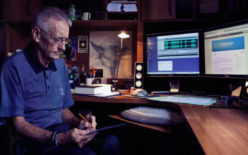Background
The hijackings on September 11, 2001 were the first such events with domestic implication since the February 12, 1993 Trans-Atlantic hijacking of Lufthansa Flight 592. I recently found work I had done on the Commission Staff concerning the historical perspective of the hijacking of American Airlines Flight 11 (AA 11) on 9/11. I don’t have the NARA file reference. The compilation of work files suggests I did this research during my review of the Payne Stewart incident sometime after May 2003.
Comparison
Here is a replication of the data in my work files.
| Item | Lufthansa 592 | American 11 |
| Date | February 12, 1993 | September 11, 2001 |
| Goal | Political Asylum | Unknown |
| Type | Trans-Atlantic | Domestic |
| Hijackers | 1 | 5 |
| Nationality | Ethiopian | Saudi, Egyptian |
| Weapon | Starter Pistol | Knives, Spray |
| Method | Pilot Hostage | Crew Neutralized |
| Initial Reaction | LE | Presumed LE Issue |
| Air Defense | Otis AFB | Otis AFB |
| Lead Pilot | Duffy | Duffy |
| Battle Cab | Marr (BC) | Marr (FO) |
| Weapons | Fox (WD) | Fox (SD) |
| ID/MCC | McCain (IT) | McCain (MCC/T) |
Here are the accompanying bullet points:
- Lufthansa Flight 592, Frankfurt to Cairo, hijacked to New York
- May Testimony: No domestic hijacking in last decade
- Lufthansa: First hijacking since 1986
- First trans-Atlantic hijacking since September 1976
- Multi-agency conference 2 hours and 20 minutes after FAA first notified; FBI lead, on the ground
- Otis AFB Air Defense fighters are scrambled, take handoff from Canadian jets and escort plane to JFK
Clarification
The acronyms are LE (Law Enforcement), BC (Battle Commander), FO (Fighter Officer, a position in the Battle Cab), WD (Weapons Director), SD (Senior Director), IT (Identification Technician), MCC/T (Mission Crew Commander/Technician).
The “May Testimony” reference is to the first air defense testimony to the Commission in May, 2003.
The hand-off from Canadian jets was standard procedure.
Discussion
The Commission Staff recognized early in our work that the hijacking protocol in existence on 9/11 was obsolete. Events of the day quickly bypassed existing procedures because no one really knew what the procedures involved. The key item in my work file matrix is the line “Initial Reaction.”
The mind set was, first, that AA 11 was experiencing major system failure and the air traffic control task was to clear the path. When it became clear that there was a probable hijack the mind set changed to a perceived need to get air defense involved to intercept and escort the plane to its unknown destination where law enforcement would take over once the plane was on the ground, just as had been done with the Lufthansa flight nearly nine years earlier.
Exercises over the years played lip service to the hijacking protocol; it was never seriously tested. Researchers can gain some sense of how events were handled at the Northeast Air Defense Sector (NEADS) by referring to my discussion of Exercise Vigilant Guardian. In sum, higher echelons were played notionally by the exercise cell at NEADS.
Key Point
I have commented on this before in other articles. NEADS (and Otis) had the most experienced personnel possible on duty on 9/11 concerning hijackings. The lead pilot in both 1993 and 2001 was Lt Col Timothy Duffy (link is to Otis AFB). Colonel Robert Marr, NEADS commander on 9/11, was the Fighter Officer, the key staff officer in the Battle Cab in 1993. Major Fox, Senior Director on 9/11, was the Weapons Director who controlled the fighters in 1993. MSGT McCain, the Mission Crew Commander/Technician on 9/11, was an Identification Technician in 1993, and would have been involved in locating and identifying the Lufthansa flight.
Longevity in service at one organization is typical of assignments in the Air National Guard. For example, Brigadier General Dawne Deskins, the NEADS officer who received the first set of coordinates for AA 11 from Boston Center on 9/11, ultimately commanded NEADS. She was promoted to her current rank in March, 2014.
Perspective for Historians
There have been just four domestic hijackings in the last quarter century, all of them on September 11, 2001. Prior to 9/11, there had not been a domestic hijacking for years. The single hijacking incident that tested the nation’s air defense was the Lufthansa case. That turned out to be a test of routine procedures.
The routine procedure was that air defense would be tasked to intercept and escort and to “identify by type and tail” as was the case on 9/11. Boston Center was not looking for fighters to engage a target they were looking for fighters to intercept AA 11 and escort it somewhere.
